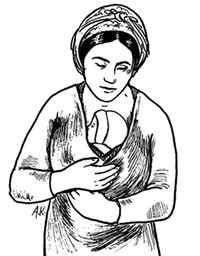As part of World Prematurity Day we are looking at ways that skin to skin can help to support premature babies and newborns after birth. Much is written on Kangaroo Care but this article focuses on an adaption of that practice known as Kangaroo Mother Care (KMC), which I believe is the most gentle way to welcome a baby into the world and enable a new mother to embrace her new role. I have summarised some of the many points from the website www.kangaroomothercare.com which is an incredible resource and showcases much of the work of Dr Nils Bergman, a renown specialist in this area.
I have also learnt about the practice of KMC with new mothers in poverty living in Malawi from my working with new mothers and babies in the community. If a baby is born prematurely and there are limited medical resources, a mother’s body can literally save the life of her baby. A new mother’s body is designed to nurture her baby and help him thrive. It’s truly nature’s way to support new life and help a mother & baby connect and bond for health and wellbeing.
What is it?
Kangaroo Mother Care (KMC) is
“the early, prolonged, and continuous skin-to- skin contact between the mother (or substitute) and her low birth weight infant, both in hospital and after early discharge, until at least the 40th week of postnatal gestation age, with ideally exclusive breastfeeding and proper follow-up” (Cattaneo, Davanzo, Uxa 1998).
The early discharge relates more specifically to babies with medical problems or premature babies.
It’s origins
It was first presented by Dr Rey in Bogotá, Colombia in 1978 and later developed by Dr. Hector Martinez and Dr. Luis Navarrete as an alternative to inadequate and insufficient incubator care for those preterm newborn infants who had overcome initial problems and required only to feed and grow.
Almost two decades of implementation and research have made it clear that KMC is more than an alternative to incubator care. It has been shown to be effective for thermal control, breastfeeding and bonding in all newborn infants, irrespective of setting, weight, gestational age, and clinical conditions.
The difference between Kangaroo Care and Kangaroo Mother Care.
Skin to Skin is the actual intervention used as in Kangaroo Care whereas Kangaroo Mother Care compromises of a general approach in which skin to skin contact is a key component
“Kangaroo Care” (KC) means doing skin-to-skin contact between baby and mother (or father), anything from 10 minutes to an hour or more a day. KC requires that the baby is “stable”, and so may be already a week old or more. The usual technical definition is “intra- hospital maternal-infant skin-to-skin contact…..KMC makes mother more central to the team which is good and promotes breastfeeding which can of itself be life-saving for prems” Nils Bergham
Nils Bergman states that skin to skin contact should start from birth.
“In mammalian research, separation tolerance is measured in minutes!! The underlying neuroscience is that the baby is stressed for most of the time as she is separated from Mum, and this stress keeps the baby unstable. Holding your baby in skin-to-skin for over an hour is needed to make a full sleep cycle, which wires brain circuits. It also decreases the load of stress which protects from long term “wear and tear” effects on baby organs and metabolism. The neurobiology also changes, the constant sense of safety makes for better emotional and social development”
In a study by Dr Bergman (2004), all the premature babies starting skin-to-skin contact from birth stabilised within 6 hours. Only half the premature babies placed in incubators stabilised.
Who should practice Kangaroo Mother Care?
Preterm or low birth weight babies admitted to a neonatal intensive care unit or special care baby unit when medically stabilised. It is possible even if a baby is incubated.
Well preterm and low birth weight babies.
Full term, well babies.
Babies who have been separated for some reason from their mothers to aid in maternal attachment Mothers and babies who wish to establish breastfeeding and maintain milk supply
Benefits
Dr Joy Lawn shows that Kangaroo Mother Care is one of the most powerful and effective ways to save premature babies
“Acceptance of the KMC method is increasingly widespread and it is considered equivalent to conventional neonatal care for stable preterm infants and more parent and baby friendly…It is evident that KMC has a substantial mortality effect compared with conventional neonatal care, and it is also evident that this mortality benefit is possible even at large scale….No matter if babies are born in Lilongwe, London or Los Angeles, preterm babies need extra care to survive. Kangaroo Mother Care is low-cost and feasible, and we now have proof it is one of the most highly effective ways to give more babies the chance to survive and thrive.”
Nils Bergham says;
“Emotional intelligence begins with the wiring of the approach pathway, which comes from feeling safe in skin-to-skin contact. The eye-to-eye contact, bonding, love and trust are the start of social intelligence. Together these form the basis for all other relationships. Right in these first minutes of life both emotional and social intelligence are being fired and wired into your baby’s brain”
How and why does Birth KMC work?
Regulation: The baby at birth is wide awake for the first 60-90 minutes and expecting certain sensations. He hears mum’s familiar voice, heartbeat and the smell of mum. The baby feels SAFE and so his body calms down. Heart rate, breathing and oxygen saturation, blood pressure and temperature all stabilise far faster when a baby is given to mum than when they are separated. Baby has his basic needs for warmth, food and protection met.
Bonding and attachment: Baby’s brain also calms and all of the expected sensations are collected and fire pathways in the brain. The baby will feel safe and open his eyes to make contact with his mother. This is the start of early bonding, and emotional and social intelligence. This is the first and most essential bond, the basis of all other bonds in life. Being physically close to your baby is one of the most stabilising and loving things you can do after birth. Your body is an incredible gift to your baby and can provide all he needs.
Breastfeeding: The baby crawls to the breast and starts to suckle on his own, with a proper latch so breastmilk production is being stimulated early on.All of the hormones in mother and baby work together as they were designed to. There are some remarkable videos of babies crawling to the breast from the belly attracted by the contrast in shapes and smell of breast milk.
Sleep: The baby will then settle to sleep, and during quiet sleep all of these sensations collected will fire and wire circuits to the emotional brain, be organised and sent back to the cortex when he wakes again, thus completing the brain circuits for healthy development.Sleep is vital for the brain growth of babies and to give “newborn mothers” a chance to recover from birth and early motherhood demands.
How to practice skin to skin contact in KMC
1. Place the baby in just a nappy and a hat.
2. Make sure your hands are clean, Wash them before you handle baby.
3. Remove any perfume or strong smells.
4. Put the baby inside your clothing so you are completely skin to skin. She should be chest on your chest with the legs in a foetal position as it supports the hips. You can place your hands under her bottom. You can then wrap or cover the both of you to insulate the heat between you. Use a natural fibre like cotton.
5. Sit comfortably at an angle of 30-40 degrees if possible as this help breathing.
6. How long you sit their is down to you and your baby. Always tune into your baby’s cues. An hour is a suitable time but longer skin to skin can also be offered.
Additional Guidance from Royal College of Midwives
• Baby’s arms and legs should be flexed, in a frog-like position.
• Babies are obligatory nose breathers and should be positioned to minimise obstruction to the nasal airways
“Kangaroo Mother Care is summed up well with this simple lesson: Never separate a mother and her newborn unless it is absolutely unavoidable. All young babies should be kept close to their mother’s body in her arms or in a sling during the day, and sleep close to her at night. The brain is a psychosocial organ, and babies brains grow as their mothers interact with them in loving and gentle ways. This is how they learn the basis of having healthy relationships with their own partners and children one day” http:// www.kangaroomothercare.com

